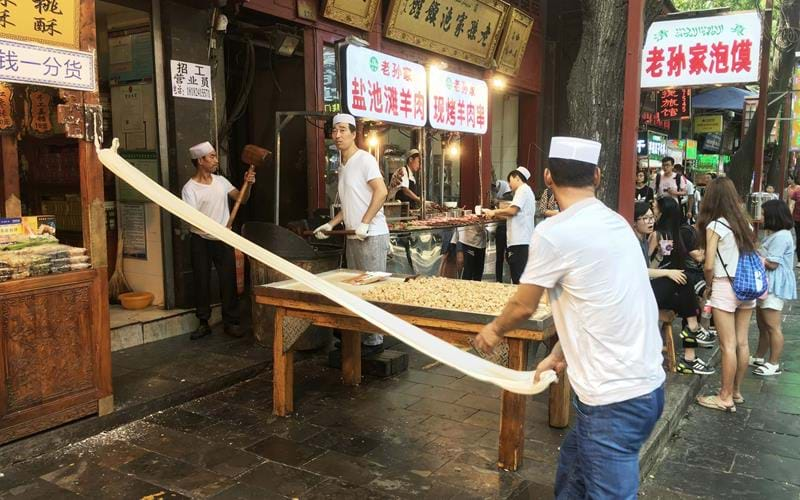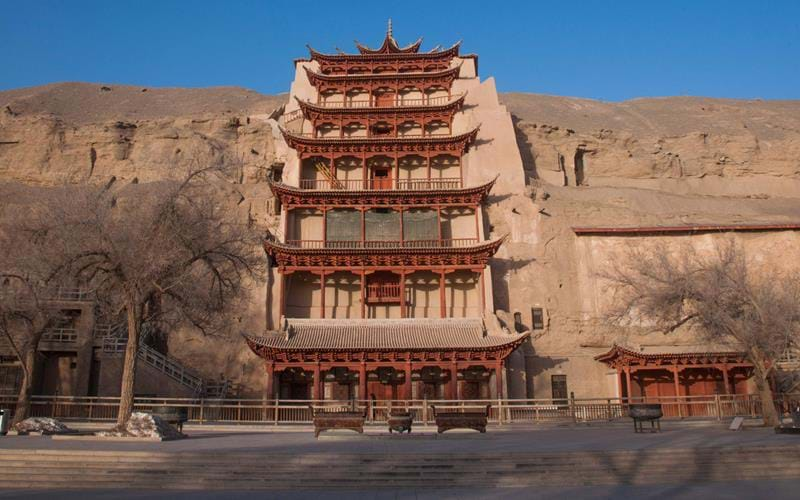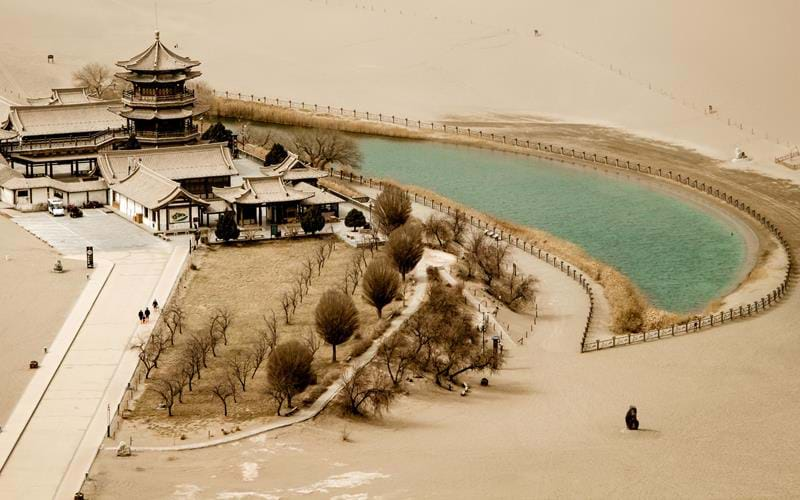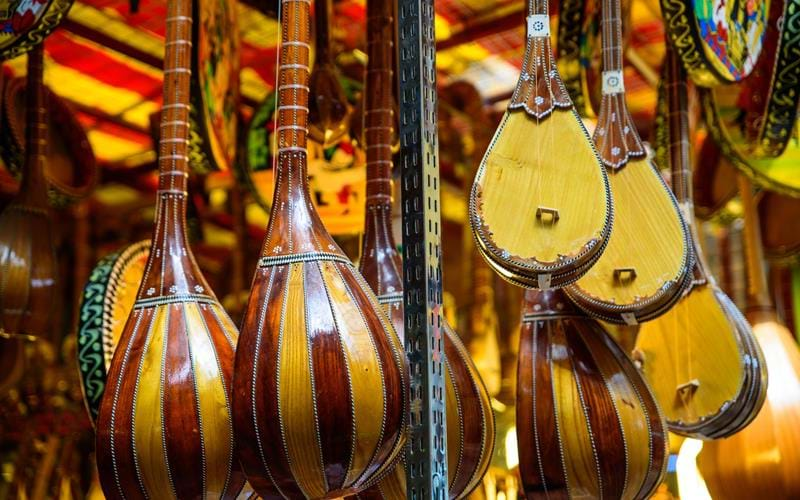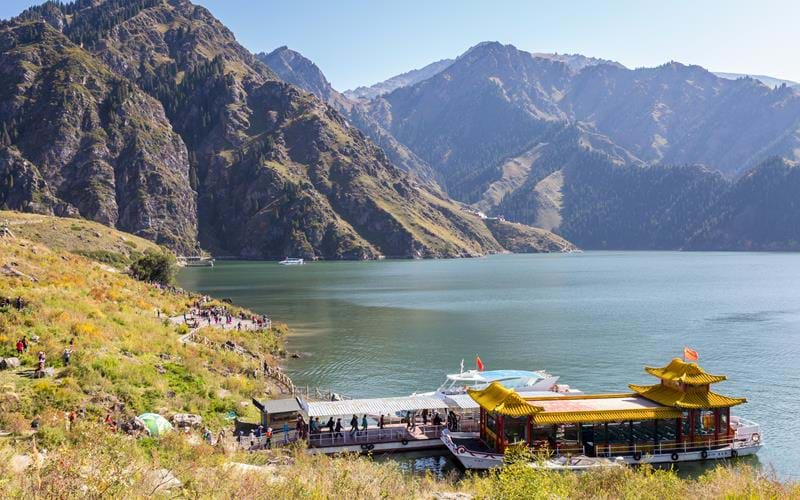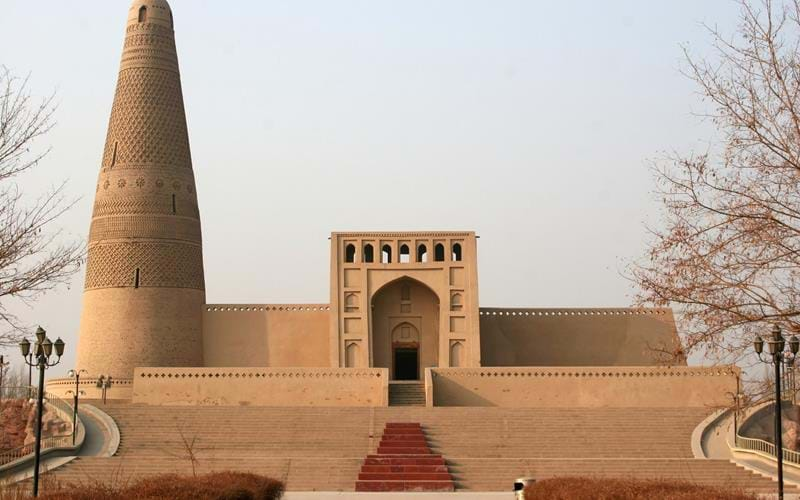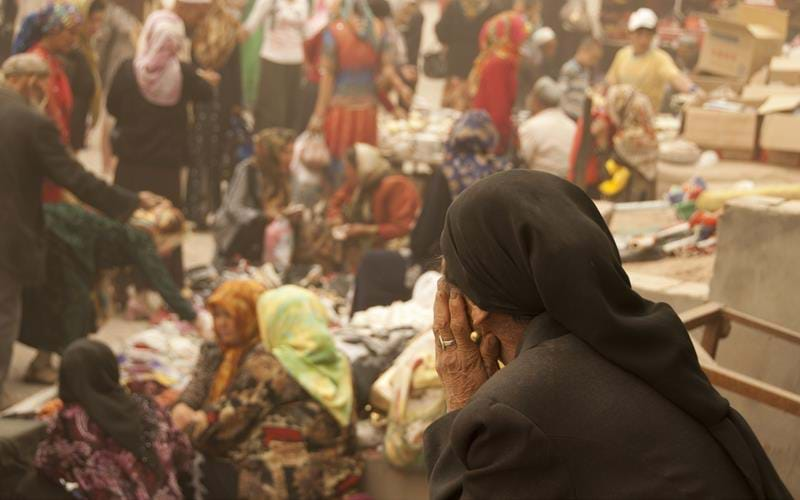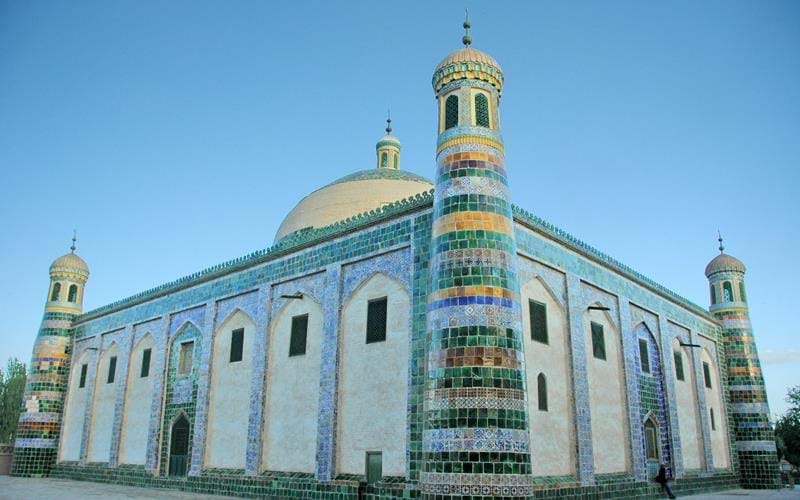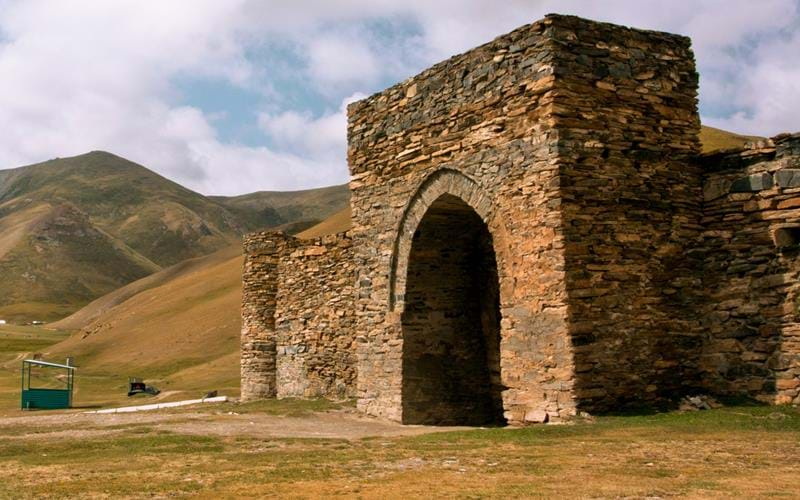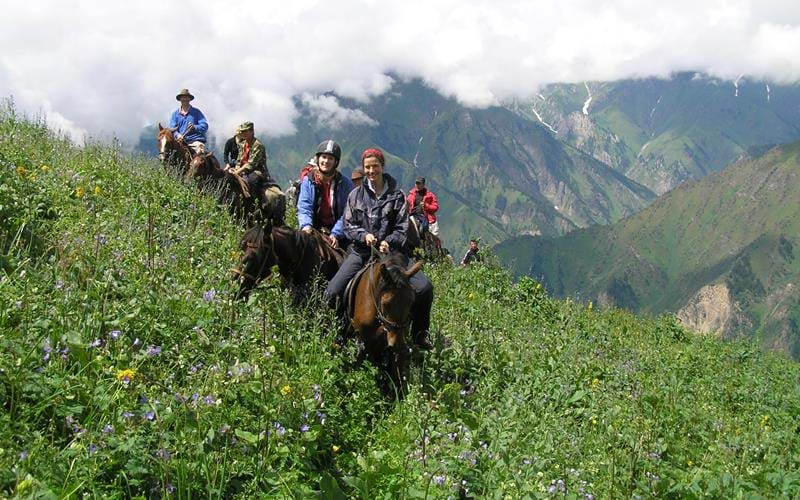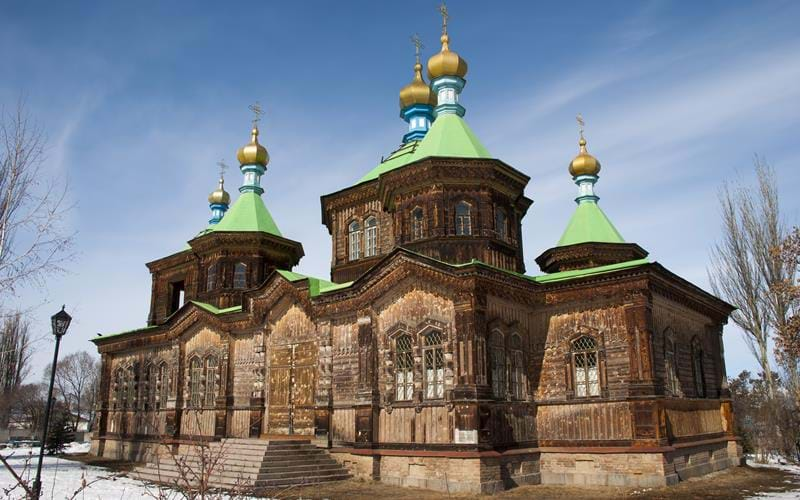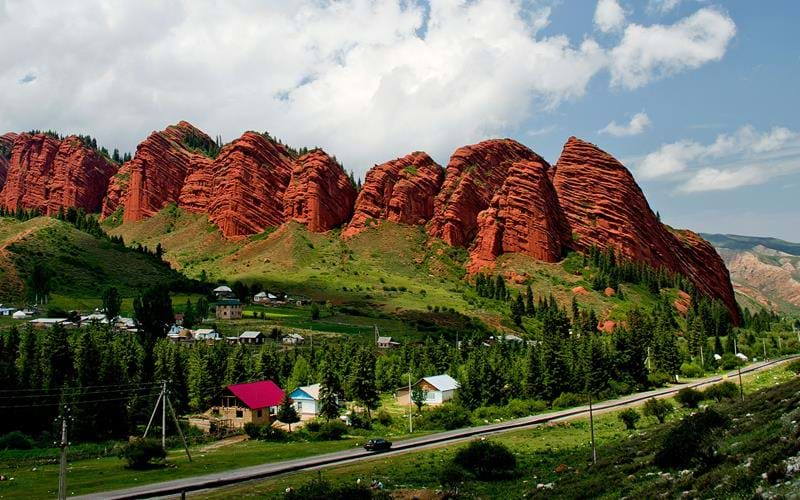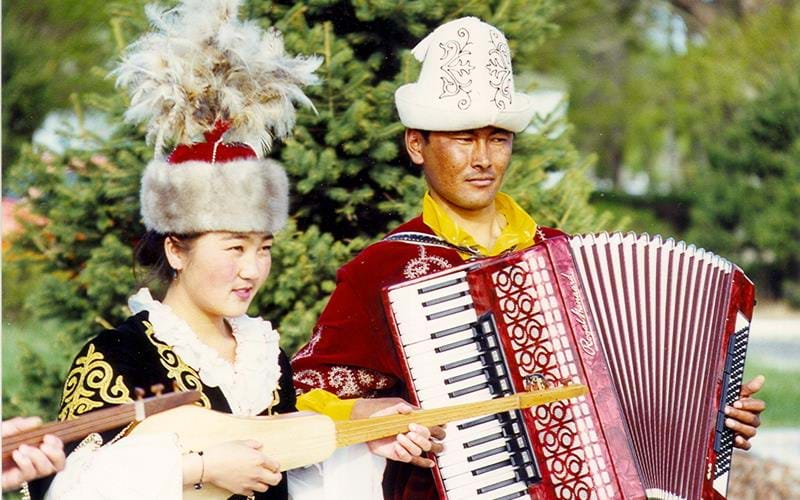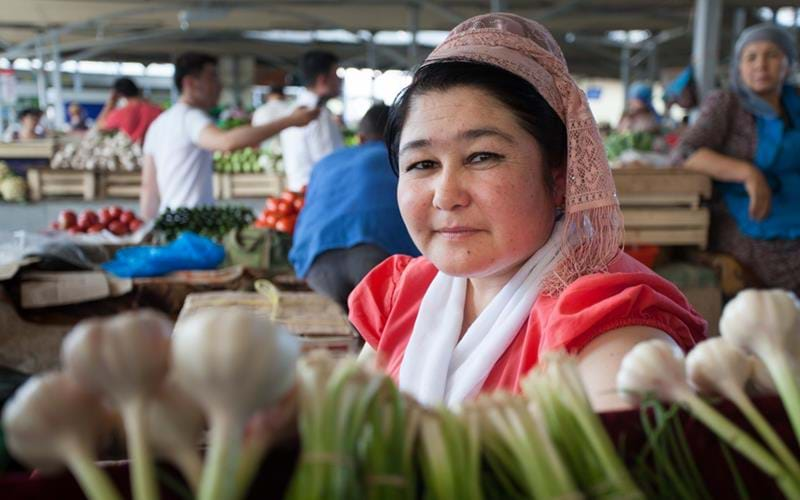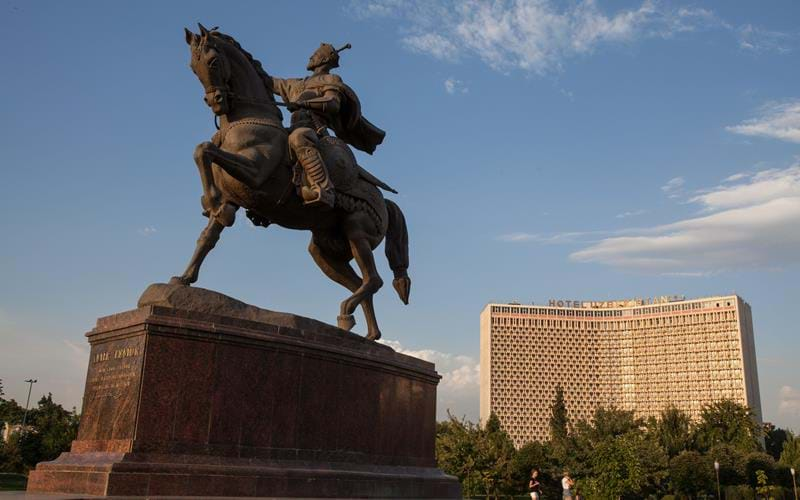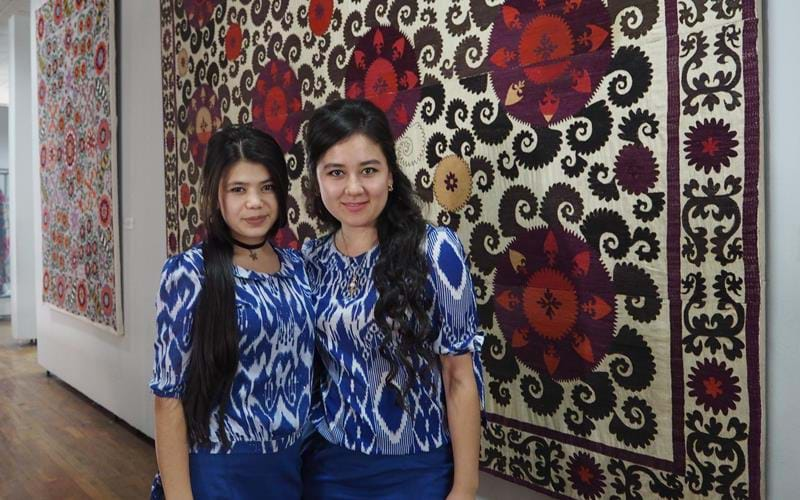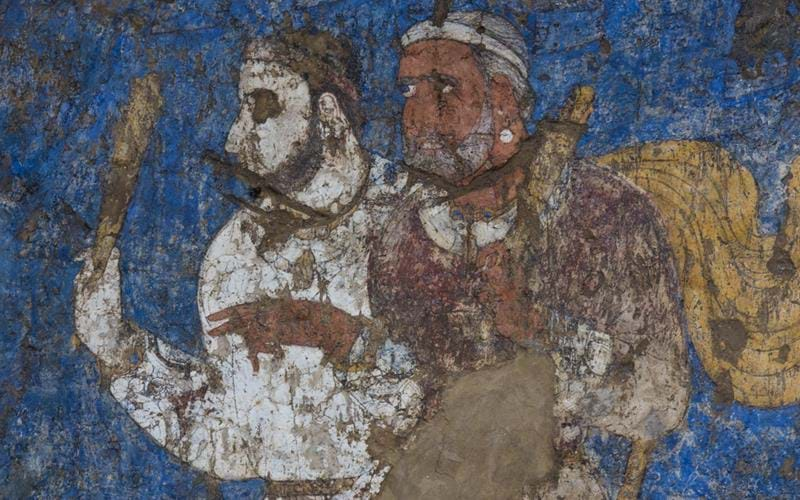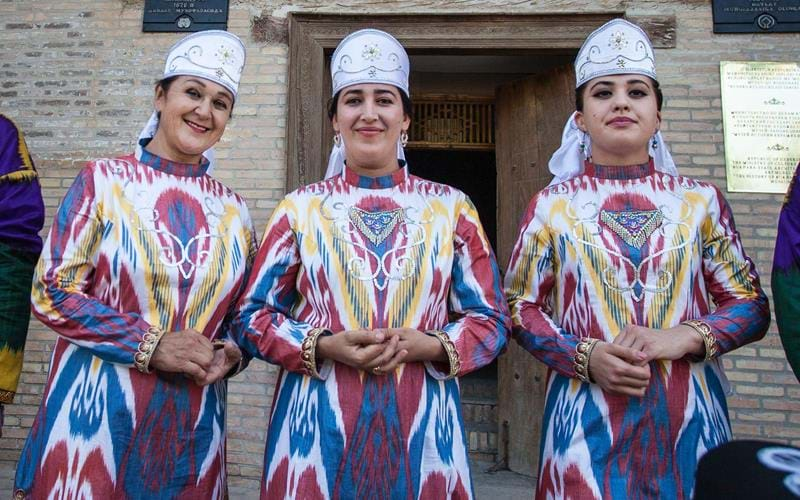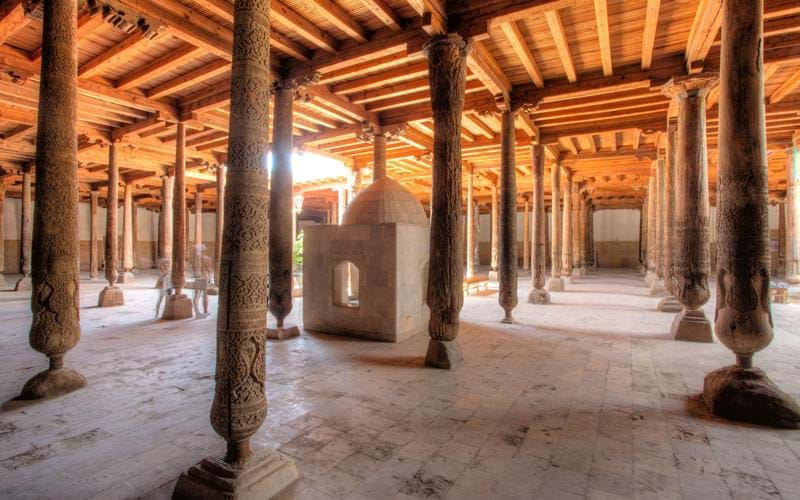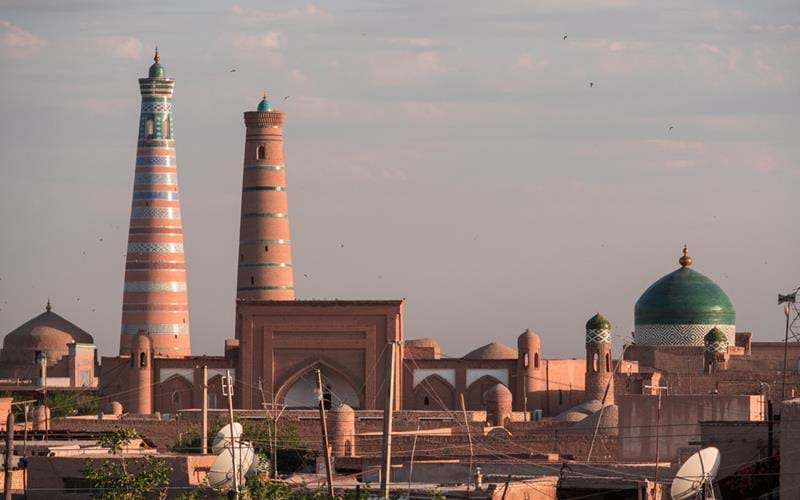Combining the highlights of Uzbekistan with those of neighbouring Turkmenistan, this itinerary is our recommended option for adventurous travellers wishing to experience the ruined cities…
View more
For anyone hooked on the romance of the ancient Silk Road, this epic, month-long tour has it all. You get to experience the full gamut of exotic landscapes explored by Sven Hedin and Aurel Stein, and visit all the legendary bazaar cities that once formed stepping stones for caravans crossing from China to the West. Unlike the intrepid souls of former eras, however, you’ll be travelling in great comfort, crossing over the shifting dunes of the Taklamakan in a jet plane rather than on a Bactrian camel (though there will be opportunities for short rides should you wish!).
That said, the route does include its fair share of overland adventure – not least the traverse of the Torugart Pass, the famous passage through the Tianshan range dividing Xinjiang in the far west of China from Kyrgyzstan. Long days on the road are numerous, but never arduous. You’ll be driven in a plush vehicle, and have the distraction of some of the world’s most awe-inspiring scenery to gaze at through your window. We call this gold-standard route between Xian and Khiva our ‘Ultimate’ tour because, by our reckoning, it delivers the finest experience possible over the span of one month.
Cultural Holidays River Cruising Holidays Adventure Holidays
Fly from the UK to Xi'an on an indirect flight.
On arrival at Xi'an airport, you’ll be met by your guide and escorted to your hotel. Spend the rest of day recovering from your journey, perhaps with a short, acclimatising stroll around the Muslim Quarter in the evening.
Filled with the aromas of baking bread and sesame oil, the bustling main street of Xian’s Muslim (‘Hui’) neighbourhood, Beiyuanmen, comes alive after dark, when dozens of open kitchens serving traditional snacks and meals do a roaring trade. Try the famous Jiansan steamed buns and glistening red persimmon pies. Descended from the Arab and Persian merchants who first arrived in the Chinese capital in the 7th century, the Hui – and their trademark dishes – are a living legacy of the ancient trade across the great deserts to the west. Around one thousand of them attend Friday prayers at the city’s Great Mosque, an exquisite old building blending classical Chinese and Islamic styles.
Begin your first day’s sightseeing with a round of Xi'an’s Ming ramparts in the morning, then visit the ancient Wild Goose Pagoda before driving out of the city to see the Terracotta Army after lunch.
The city’s impressive Ming ramparts form a huge rectangle around the centre that’s best covered by bicycle – a wonderful ride affording fine panoramic views. Next, pay a visit to the six-storey Wild Goose Pagoda, built to hold the precious Buddhist texts brought back from India by the monk Xuan Zang in the 7th century. In the afternoon you’ll head east out of the city to see the Terracotta Army. Apart from the pits holding the clay warriors themselves, the site encompasses a giant mound holding the unexcavated tomb of the Ching Emperor, and a museum jam-packed with precious finds.
After breakfast, transfer to the airport for your flight to Dunhuang, home of the greatest of all the historic monuments punctuating the Silk Road: the Mogao Caves.
Dating from between the 4th and 14th centuries, the Mogao Caves complex is the world's richest storehouse of ancient Buddhist sculpture and murals. For hundreds of years, precious manuscripts from India and beyond (including the Diamond Sutra, the world’s oldest printed book) were also brought here by travelling monks and secreted in a sealed cave on the site, where Aurel Stein discovered them between 1907 and 1914, eventually carrying the horde off to the British Museum (where it still resides).
A full day’s sightseeing is allotted for this extensive UNESCO World Heritage site. You’ll also have time to visit the Crescent Moon spring, which flows into a small lake cradled by the huge shifting sand dunes outside Dunhuang.
Created over a period of around 700 years, Dunhuang’s cave paintings decorate hundreds of separate excavations, although only the 20 most impressive are open to the public today. You’ll probably get through around 15 in your tour, which will also pause at the site’s state-of-the-art Research and Exhibition Centre, to look at the detailed facsimiles and displays on the history of the Silk Road.
Dunhuang’s ‘Crescent Moon Lake’ occupies a depression amid a tract of vast dunes outside the town. Visits are best in the evenings, when the crowds who come to climb the sand hills and enjoy toboggan and camel rides thin out considerably.
Today you’ll fly to the capital of Xinjiang Province, the Uyghur city of Urumqi on the northern side of the Tarim Basin. For the rest of the day you’ll be free to explore the Grand Bazaar with your guide.
The ‘Xinjiang International Grand Bazaar’, to give it its full title, is of relatively recent vintage and lacks the authentic feel of those further west, but it certainly merits a couple of hours’ exploration. Officially the largest market in the world, it covers a vast area that’s centered in an appropriately colossal minaret (modelled on the one in Bukhara, which you’ll see later in this tour) and is an excellent source of local souvenirs, such as Uyghur musical instruments, atlas silk, local rugs and knives. At sunset time, admire the gilded domes of the Grand Mosque, then duck into a traditional Uyghur restaurant nearby for a supper of traditional ‘polo’ (pilau rice) and lamb kebab.
Visit Urumqi’s wonderful museum in the morning, and head to Heavenly Lake in the afternoon.
The Xinjiang Provincial Museum ranks among the best in China, with finds from the abandoned cities of the Silk Road dominating its archaeological collection. The undoubted show stealers are the amazingly well-preserved mummies, some of which – intriguingly – have fair hair and blue eyes! After lunch you’ll set off for one of the province’s best-loved viewpoints, overlooking the shores of Tian Chi (‘Heavenly Lake’), in the lap of the Tianshan Mountains to the north of the city. Framed by snow peaks, pine forests and grassy meadows, the turquoise coloured water contrasts vividly with the backdrop of 6,000-metre mountains, which include mighty Bodga Feng.
One of the highlights of the northern branch of the Silk Road is the town of Turpan, which you’ll visit on a day trip from Urumqi.
An early start will be required today as you drive southeast across the Taklamakan to Turpan. Start with a visit to the pot-bellied, round-topped Emin Minaret, which you can scale for a fine view of the surrounding snow peaks, then head to Bezeklik ‘Thousand Buddha Caves’ complex and fascinating Karez Irrigation Site, where you can see the system of channels that has directed meltwater to the area from the Tian Shan range for more than 2,000 years. Experience the resulting fertility yourself in the afternoon with a tour of a local grape farm in the Uyghur village of Tuyoq.
It’s time to fly west across the vast, drifting sands of the Tarim Basin to the town that once straddled the crossroads of High Asia – Kashgar.
Having squeezed around the edges of the Taklamakan Desert, the northern and southern Silk Roads converged on Kashgar, Xianjing’s westernmost city. Crowds of farmers and nomads still flock in each week for its famous Sunday market, the Yekshenba Bazaar – one of the great sights of the Silk Road. Hand-woven carpets, kilims and jade jewellery from Khotan, along with ornately decorated knives from nearby Yengisar, can be bought at bargain prices. Relaxing in teashops, tucking into kebabs of charcoal-grilled lamb and watching the amazing assortment of Turkic faces, embroidered caps, donkey carts and camels lope past are what a visit to Kashgar is all about.
Enjoy a full day’s sightseeing in Kashgar today, beginning with a visit to the green-glazed Aba Khoja Mausoleum – the city’s defining landmark.
One of the finest examples of Islamic architecture in China, the Aba Khoja complex retains superb decorative tilework on its exterior and painted wood carving inside, where five generations of the same family are entombed. Your guide will also show you around the few surviving areas of Kashgar’s mud-and-thatch Old Town, where you’ll be invited to take tea in a typical Uyghur home. Next up will be the city’s covered bazaar – look out for local knives and instruments that would have been familiar to Tamerlane and Genghis Khan. If you happen to be here on a Sunday you’ll also be able to visit the famous great livestock market.
One of the world’s great road trips begins today as you drive over the watershed of the snow-capped Tianshan (‘Celestial Mountains’) to the old caravanserai of Tash Rabat in Kyrgyzstan.
A succession of spectacular valleys, flanked by denuded mountainsides of scree and ochre cliffs lead to the gateway through the Tian Shan range: the 3,752-metre Torugart Pass. This will be a relatively taxing day involving potentially lengthy border formalities. Ensure you have a warm jacket on hand – the temperature will drop noticeably as you ascend. Once clear of Chinese customs, continue across to the Kyrgyz border, where you change cars and guide. Continue on to the beautiful 14th-century caravanserai at Tash Rabat, where you’ll spend the night in a traditional yurt.
More wonderfully wild scenery awaits on the twelfth day of your Silk Road adventure, as you descend from Tash Rabat across the grasslands of central Kyrgyzstan, passing numerous nomad encampments in the lee of soaring peaks.
Your ultimate destination today will be one of the most visually arresting, and uplifting, natural spectacles in Central Asia: Song Kol Lake – a shimmering expanse of blue water encircled by swaths of grass and hillsides. You’ll spend the night in a yurt camp by the lakeshore. Weather permitting, the night skies will be among the starriest you’ll ever experience.
A full day is set aside to recover from your long road journey over the Tianshan. Spending it relaxing at camp, walking along the shoreline of Song Kol and riding horses up to the surrounding ridges.
Today you cross the Ala-Too range to reach the largest lake in Kyrgyzstan (in the fact the second largest body of freshwater on the planet after Titicaca) – Issyk Kul.
Feeling more like an inland sea, the lake has its own mild micro-climate and is surrounded by magnificent scenery, and some fascinating monuments. You’ll spend the night in a small but comfortable hotel in the town of Balykchy, set back from the lakeshore. Lunch will be in Kochkor, where there’s a lively bazaar, as well as some interesting crafts workshops to visit should you wish.
This morning you’ll get your first proper look at Issyk Kul, as you head out of Balykchy and drive along the lake’s southern shoreline to Karakol. Weather permitting, the vistas south across the water to the snowfields of the Tianshan will be wonderful.
In the course of the day you’ll visit a yurt-making workshop, take tea with a local family in a typical Kyrgyz village and enjoy picnic lunch on the lakeshore. Before reaching the end of the day’s journey, you’ll also explore the Skazka ‘Fairy Tale’ Canyon, famed for its weird red and ochre rock formations. Your night halt will be at a guesthouse in the town of Karakol, a former Russian colony that preserves much of its traditional Tsarist-era wood architecture, including a magical little Orthodox church. For supper, you’ll have the option of dining in a local restaurant or with a local family.
After a tour of Karakol’s sights, you’ll drive out to the scenic Jety Orguz Gorge, cradled by the northern slopes of the Terskei Ala-Too range, returning to Karakol for supper.
The Jety Orguz valley is known principally for its striking sandstone landforms, foremost among them the blood-red crags of the ‘Seven Bulls’. Beyond, the road winds along the river through beautiful forests of blue spruce, crossing no less than five log bridges before arriving at the flower meadows of Kok Jaiyk at the upper reaches of the Jety Orguz Valley, overlooked by the shining ice summits of Orguz Bashi peak (5,165m).
After breakfast, the next stage of your journey takes you to the capital, Kyrgyz Bishkek via the petroglyphics of Cholpon Ata and spectacular Boom Gorge, a popular site for white-water rafting.
Spend the remainder of the day souvenir shopping. In the evening you’ll have the option of attending a culture show in a local restaurant featuring recitals of traditional Kyrgyz instrumental music and song.
A full day’s sightseeing in the capital starts with a tour of its principal landmark, Ala-Too Square, where you’ll watch the changing of the guard ceremony before heading off to the National Museum.
After lunch at a local café serving traditional Kyrgyz cuisine, you’ll be shown by your guide around Bishkek’s largest market, Osh Bazaar – a great source of authentic souvenirs, such as the distinctive felt hats worn by many Kyrgyz men of a certain age.
An early start will be required to catch your flight to Tashkent, capital of neighbouring Uzbekistan. Spend the rest of the morning recuperating at your hotel, then slot in a quick tour of the city’s 14th century mosques and madrassas in the afternoon.
After a late lunch at a traditional Uzbek restaurant, a gentle afternoon’s tour begins at the Hast Imam complex in old Tashkent, whose handsome 14th century mosques, tomb and madrasa today host workshops for traditional crafts. Highlight of the visit is a glimpse of one of the world’s oldest Qurans. We’ll wind up the tour with a stroll around the centrepiece of the modern city, Amir Timur Square, home to a huge equestrian statue of Uzbekistan’s eponymous national hero, better known in the West as ‘Tamerlane’. On western side, the gleaming white-marble Congress Hall is crowned by a pair of silver storks, symbols of ‘Peace and Happiness’.
After breakfast, visit the capital’s Museum of Fine Arts, whose collection spans 1500 years of Central Asian history and culture. A trip to Chorsu Bazaar, Tashkent’s largest market, takes up most of the afternoon.
Among the many on display at the national museum are some of the Asia’s most sumptuous antique carpets, a collection of ancient suzani embroidered silk wall hangings and Buddhist figurines from the pre-Islamic Silk Road era. Lunch today will be at the famous Plov Centre, high altar of the national dish of Uzbekistan, plov – a regional take on pulao made with sizzling lamb, rice, vegetables and apricots. Afterwards, we’ll head uptown to explore Tashkent’s bustling market – Chorsu Bazaar – where you can buy everything from embroidered Uzbek hats to wedding gowns and bowls of juicy mulberries. Photographers will be in their element.
After breakfast your guide will accompany you to the railway station to catch the high-speed service to Samarkand. In the afternoon, drive over the Gysar Mountains to Shakhrisabz, birthplace of Amir Timur, aka ‘Tamerlane’.
Located 50 miles (80km) south of Samarkand, Shakrisabz was the birthplace of Timur – a fact celebrated by a crop of wonderful 14th and 15th century monuments, foremost among them the majestic Kok Gumbaz mosque, with its three vibrant turquoise domes. The remnants of Timur’s own Summer Palace, the Ak-Saray, come a close second: sublime blue, white and gold mosaics embellish the surviving gateway of the building. Crafts traditions dating from the time of Timur still thrive at the famous Khudjum Embroidery factory, an all-women cooperative where 1,600 workers weave carpets, mats, traditional Uzbek silk gowns and skull caps.
Enjoy a full day’s sightseeing in the greatest city of all on the Central Asian Silk Road.
After breakfast, visit the spectacular ‘Registan’, Samarkand’s great showpiece. The complex is made up three separate madrasas, or theological colleges, lining three sides of a huge plaza. Behind the richly decorated facades are hidden cloistered courtyards where the former priests’ and students cells hold small crafts and souvenir shops. After the Registan, you’ll visit the giant Bibi Khanym mosque, before a wander around nearby Urgut market. In the afternoon, watch how silk is processed and woven into exquisite rugs at a local carpet factory, then head to the Shah-i Zinda to see the intricately tiled tombs of the Timurid queens.
In the morning, visit the Ruins of Sogdian Afrosiab, a site occupied from the 7th century BC until 1220 AD, before embarking on a journey west through a great swath of oasis in the Kyzyl Kum desert to Bukhara, where you’ll arrive in time for some leisurely sightseeing in the late-afternoon.
Highlight of Afrosiab’s site museum is the fabulous ‘Ambassador’s Painting’, a rare survivor of the distant Sogdian era, painted over two-and-a-half-thousand years ago yet still full of vitality. Time permitting, you’ll also be able to visit a museum devoted to the legacy of the great Uzbek ruler and polymath, Ulug Begh, whose scientific discoveries, particularly in the field of astronomy, were admired by Sir Isaac Newton, among others. All being well, you should arrive in Bukhara in time for a short wander around the historic centre, near your hotel, before supper. Start at the shimmering Lyab-i Hauz pond at its ensemble of 16th century architectural masterpieces.
A full day’s sightseeing is set aside for the monuments of Bukhara, which mostly date from the 16th century and have been extensively restored in recent years by the Uzbek government.
Highlights include the sprawling Poi-i-Kalan complex and Laub-i-Hauz ensemble – both examples of Central Asian architecture at its most chimeric. In the north-west of the old walled city, the Ark fortress is a more forbidding edifice, redolent of the darker side of the regimes who ruled the city from the 5th century AD until the flight of the last Emir in 1920. In the evening, you’ll have the option of attending at folklore show at the Folklore Show at the Nadir Divanbegi Madrasa, featuring traditional Uzbek music and dance, or a fashion show showcasing the textiles and couture of local designers.
A long drive across the Kyzl Kum desert to Khiva takes up most of today. En route, you’ll traverse the Amu Darya River, known in the time of Alexander the Great (who crossed it twice) as the ‘Oxus’.
Nearly a mile wide, the Amru Darya is still an impressive sight, despite the fact much of its water is nowadays diverted into vast fields of cotton. Your lunch stop today will be at a traditional Uzbek restaurant just off the highway. Green-glazed domes and tapering minarets soar above the flat rooftops and medieval mud walls of the beautifully restored Itchan Kala, Khiva’s historic core. There will be time in the afternoon for a short walking tour of the principal monuments, beginning with the squat, elaborately tiled Kalta Minar and nearby Jama Masjid (‘Friday Mosque’), which retains carved elm pillars dating from the time of Alfred the Great!
A day’s sightseeing in Khiva begins with an ascent of the Islam Khoja minaret and ends at the tower surmounting the Kunya Ark Palace for the town’s ultimate sunset view.
The city’s tallest and most prominent building, the Islam Khoja Minaret is embellished with handsome bands of turquoise tiles. A narrow, steep flight of steps corkscrews to the viewing platform at the top where a fabulous 360-degrees view over the city is revealed. Sumptuous tilework, painted ceilings, finely carved wood pillars and exquisite calligraphy adorn the remarkable ensemble of palaces and madrasas surviving in the Itchan Kala. Your guide will lead you through the highlights in the morning, leaving you free to wander, shop or lounge on your hotel balcony in the afternoon. It’s also worth squeezing in a second visit to the Kunya Ark Palace in the evening for the sunset views over Khiva’s exotic skyline.
Today you’ll bid farewell to the world of the Timurids, transferring to Urgench airport for your flight back to Tashkent, where you’ll be met by your local TransIndus guide on arrival and escorted to your hotel.
An unforgettable month of travel across the mountains and deserts of Xinjiang and Central Asia comes to an end today as you depart the Uzbek capital and make your way with your guide to the airport to catch your flight back to the UK.
✓ International flights from the UK in economy
✓ 26 nights accommodation
✓ Domestic flights in economy
✓ All road travel and transfers by private chauffeur-driven vehicles
✓ English-speaking guides
✓ Breakfast daily
✓ Entrance fees to sites and monuments listed in tour itinerary
With the Summer almost upon us, now is the time to begin planning your next summer adventures in Asia. Our Travel Specialists are ready to take your call and discuss the adventure you have been dreaming of.
Or call us on 0208 566 3739
